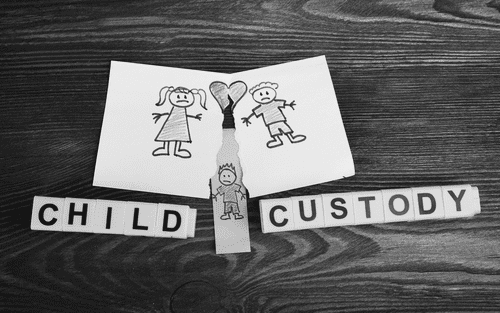A person who is not a parent of a child can obtain custody in several ways in Minnesota. “Custody” includes both the right to determine a child’s upbringing (education, health care, and religious training, among others) and the routine daily care, control and residence of a child. Custody differs from “parenting time,” which is the right to spend time with a child but doesn’t confer the above-referenced custodial rights. There are legal avenues for a nonparent to obtain parenting time without custody, or to obtain guardianship of a minor child, neither of which are the subject of this article.
A third party who seeks custody of a child can obtain an order which determines the child’s legal and physical custody, the child’s residence, a parenting schedule, child support, and other practical matters, pursuant to Minnesota statute. This can be done through a “de facto custody order,” a “third party custody order,” or a “custody consent decree.” Each option is explained below. The process is started by serving and filing a petition in the appropriate court.
Where To File
The petitioner has to file the petition in the correct state and county. The correct state is the one that has jurisdiction over custody which is determined by the Uniform Child Custody Jurisdiction and Enforcement Act. Generally, it’s the state where the child has resided for at least six months immediately preceding the filing of the petition or where the current custodial order is entered. The correct county is the one in which the child resides, is found, or where an earlier custodial order was entered.
What To File
To start a third party custody action, the person must serve the petition and notice of hearing upon the child’s parents, tribe (if applicable), guardian, and the public authority (if the child receives public assistance benefits). In the petition, the petitioner must state:
- The name and address of the petitioner and any prior or other name used by the petitioner;
- The name and, if known, the address and Social Security number of the respondent’s mother and father or guardian and any prior or other name used by the respondent;
- The name and date of birth of each child for whom custody is sought;
- The relationship of the petitioner to each child for whom custody is sought;
- Whether the person is seeking de facto custody or third party custody, and the grounds for the same (more on this below);
- The current legal and physical custodial status of each child for whom custody is sought and a list of all prior orders of custody, if known to the petitioner;
- Whether any party is a member of the armed services;
- The length of time each child has resided with the petitioner and has resided in the state of Minnesota;
- Whether a separate proceeding for dissolution, legal separation, or custody is pending in a court in this state or elsewhere;
- Whether a permanent or temporary standby custody designation has been executed or filed in a court in this state or elsewhere;
- Whether a permanent or temporary standby custody designee differs in identity from the de facto custodian and reasons why the proposed de facto custodian should have custodial priority over a designated standby custodian;
- Whether parenting time should be granted to the child’s parent(s) or guardian(s);
- Any request for temporary or permanent child support, attorney fees, costs, and disbursements;
- Whether an order of protection or a similar law of another state that governs the parties or a party and a minor child of the parties is in effect and, if so, the district court or similar jurisdiction in which it was entered; and
- That it is in the best interests of the child that the petitioner have custody of the child.
The petition must be verified by the petitioner(s) and its allegations established by competent evidence. If both parents consent to the request for third party custody, an order can be entered without a hearing. The petitioner can simultaneously seek temporary or emergency custody of the child.
De Facto Custodian
A person can be a de facto custodian if the person has a history of providing care and a residence for the child. A de facto custodian does not include a person with whom a child resides due to intervention by Social Services or adoption placement. To qualify as a “de facto custodian,” the following must be true:
- The petitioner has been the primary caretaker for the child;
- The child has resided with the petitioner for six months or more (if the child is less than three years of age) or one year or more (if the child is three years of age or older), within the 24 months immediately preceding the filing of the petition;
- During this time, there has been a lack of demonstrated consistent participation by a parent; and
- It is in the child’s best interests for the petitioner to be granted custody (more on this below).
A “lack of demonstrated consistent participation” by a parent means refusal or neglect to comply with the duties imposed upon the parent by the parent-child relationship, including, but not limited to, providing the child with necessary food, clothing, shelter, health care, and education, creating a nurturing and consistent relationship, and other care and control necessary for the child’s physical, mental, or emotional health and development. There is a list of factors the Court must consider regarding “lack of demonstrated consistent participation.
Interested Third Party
An “interested third party” is an individual who does not qualify as a de facto custodian (perhaps because the child hasn’t lived with the petitioner for a sufficient period of time), and does not include a person with whom a child resides due to intervention by Social Services or adoption placement. To qualify, one of the following must be true:
- The parent has abandoned, neglected, or otherwise exhibited disregard for the child’s well-being to the extent that the child will be harmed by living with the parent;
- Placement of the child with the individual takes priority over preserving the day-to-day parent-child relationship because of the presence of physical or emotional danger to the child, or both; or
- Other extraordinary circumstances exist.
In addition, the petitioner must prove that the requested custody order is in the best interests of the child and that the petitioner doesn’t have a disqualifying criminal history. Finally, the court must consider certain factors regarding the involvement of the petitioner in the child’s life, the involvement of the parent(s) in the child’s life, the involvement of other third parties, and facts surrounding the parent’s absence from the child’s life, and whether the child has siblings (and the placement of those siblings).
Custody Consent Decree
The final third party custody arrangement is a custody consent decree, which occurs when a parent voluntarily transfers legal and physical custody to another person. The Court must find that the custody decree is in the child’s best interests and that all parties agree after being fully informed. The decree must:
- Transfer legal and physical custody of the child to a third party and state that this includes the ability to determine the child’s residence; make decisions regarding the child’s education, religious training, and health care; and obtain information and public services on behalf of the child in the same manner as a parent;
- Indicate whether the transfer of custody is temporary or permanent; and
- Include an order for child support in the guidelines amount which is subject to income withholding, and include an allocation of child care costs and order for medical support.
Best Interests
The best interests factors for third party custody differ from those in a typical custody case. The Court must consider, evaluate, and make detailed findings on all of the following factors:
- The wishes of the party or parties as to custody;
- The reasonable preference of the child, if the court deems the child to be of sufficient age to express preference;
- The child’s primary caretaker;
- The intimacy of the relationship between each party and the child;
- The interaction and interrelationship of the child with a party or parties, siblings, and any other person who may significantly affect the child’s best interests;
- The child’s adjustment to home, school, and community;
- The length of time the child has lived in a stable, satisfactory environment and the desirability of maintaining continuity;
- The permanence, as a family unit, of the existing or proposed custodial home;
- The mental and physical health of all individuals involved;
- The capacity and disposition of the parties to give the child love, affection, and guidance, and to continue educating and raising the child in the child’s culture and religion or creed, if any;
- The child’s cultural background; and
- The effect on the child of the actions of an abuser, if related to domestic abuse, that has occurred between the parents or the parties.
If the petitioner seeks joint custody, the Court must consider whether the parties have the ability to cooperate in rearing the child, their methods for and willingness to use dispute resolution, and whether it would be detrimental to the child if one party had sole authority to determine the child’s upbringing, and whether domestic abuse has occurred between the parties.
Conclusion
If you have questions regarding this topic, then seek the advice of a family law attorney. Contact the SW&L family law team at 701-297-2890 or email us at: info@swlattorneys.com.
The information contained in this article and on this website is for informational purposes only. Do not rely on the information on this website as legal advice.










